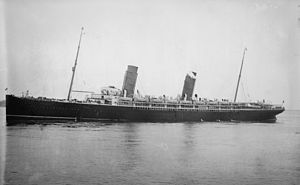RMS Lucania

RMS Lucania
|
|
| History | |
|---|---|
| Owner: | Cunard Line |
| Port of registry: | Liverpool, United Kingdom |
| Builder: | Fairfield Shipbuilding and Engineering Company yard in Govan, Scotland |
| Yard number: | 365 |
| Launched: | Thursday, 2 February 1893 |
| Christened: | Sir William Pearce, MP |
| Maiden voyage: | 2 September 1893 |
| Fate: | Scrapped by Thos W Ward after being damaged by a fire at Liverpool on 14 August 1909 |
| General characteristics | |
| Class and type: | Ocean liner |
| Tonnage: | 12,950 gross register tons (GRT) |
| Length: | 622ft (189.6 m) |
| Beam: | 65 ft 3 in (19,9m) |
| Depth: | 41 ft 10 in (13.7m) |
| Installed power: |
|
| Propulsion: | Two triple-blade propellers. |
| Speed: |
|
| Capacity: |
|
| Crew: | 424 |
RMS Lucania was a British ocean liner owned by the Cunard Steamship Line Shipping Company, built by Fairfield Shipbuilding and Engineering Company of Govan, Scotland, and launched on Thursday, 2 February 1893.
Identical in dimensions and specifications to her running mate RMS Campania, RMS Lucania was the joint largest passenger liner afloat when she entered service in 1893. On her second voyage, she won the prestigious Blue Riband from the other Cunarder to become the fastest passenger liner afloat, a title she kept until 1898.
Lucania and Campania were partly financed by the Admiralty. The deal was that Cunard would receive money from the Government in return for constructing vessels to admiralty specifications and also on condition that the vessels go on the naval reserve list to serve as armed merchant cruisers when required by the government. The contracts were awarded to the Fairfield Shipbuilding and Engineering Company, which at the time was one of Britain’s biggest producers of warships. Plans were soon drawn up for a large, twin-screw steamer powered by triple expansion engines, and construction began in 1891, just 43 days after Cunards' order.
Lucania and Campania had the largest triple-expansion engines ever fitted to a Cunard ship. These engines were also the largest in the world at the time, and still rank today amongst the largest of the type ever constructed. They represent the limits of development for this kind of technology, which was superseded a few years later by turbine technology. In height, the engines were 47 feet, reaching from the double-bottom floor of the engine room almost to the top of the superstructure – over five decks. Each engine had five cylinders. There were two high-pressure cylinders, each measuring 37 in (940 mm) in diameter; one intermediate-pressure cylinder measuring 79 in (2,000 mm) in diameter; and two low-pressure cylinders, each measuring 98 in (2,500 mm) in diameter. They operated with a stroke of 69 in (1,800 mm). Steam was raised from 12 double-ended scotch boilers, each measuring 18 ft (5.5 m) in diameter and having eight furnaces. There was also one single-ended boiler for auxiliary machinery and one, smaller, donkey boiler. Boiler pressure was 165 lb, and enabled the engines to produce 31,000 ihp (23,000 kW), which translated to an average speed of 22 knots (41 km/h), and a record speed of 23 1⁄2 knots. Normal operating speed for the engines was about 79 rpm.
...
Wikipedia
